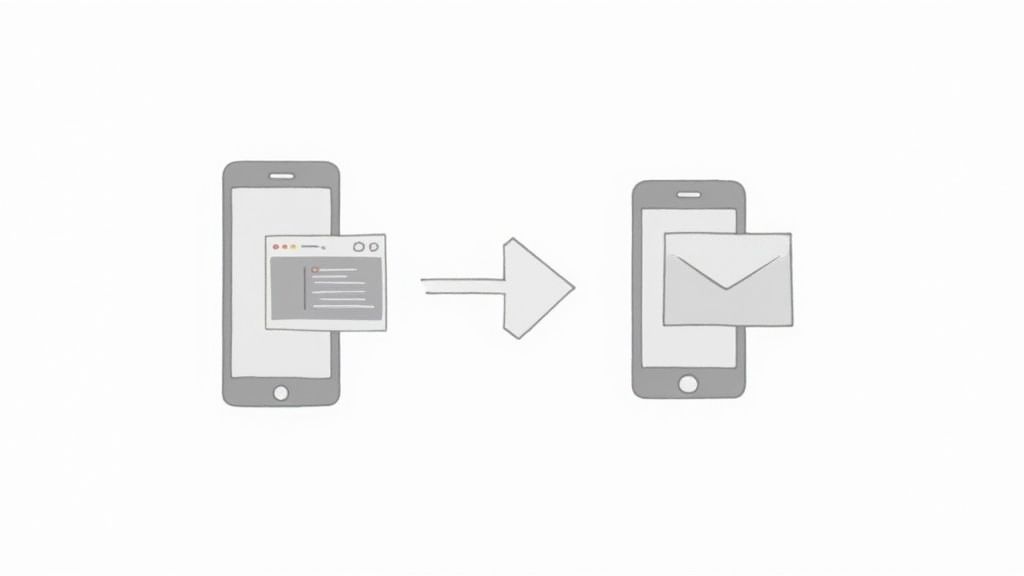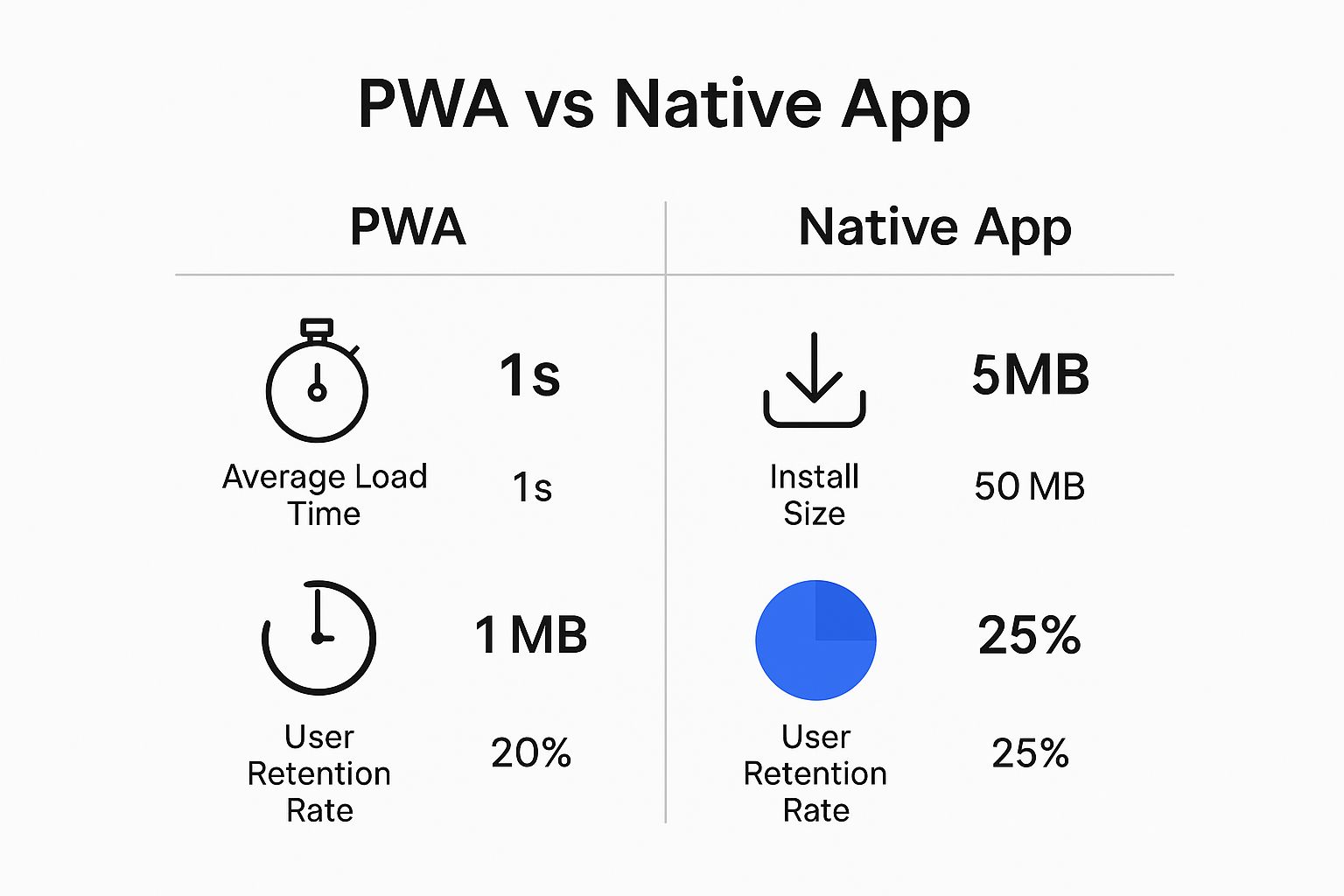
Ever feel like your website could be doing more? A lot more? That’s the simplest way to think about a Progressive Web App, or PWA for short. It's essentially your standard website that's been given some of the best features of a native mobile app.
Your Website, But With App-Like Superpowers

A Progressive Web App is a clever piece of hybrid technology. It blends the easy-to-find nature of a website with the slick functionality of an app. It starts its life as a regular website you’d open in a browser like Chrome or Safari, but it brings a whole set of app-like abilities to the table.
Unlike a traditional website, a PWA can be installed directly onto a user's home screen with a single tap. There's no need to go hunting through an app store. This instant access is a massive advantage for any business wanting to connect directly with its customers.
The Best of Both Worlds
This innovative approach bridges the gap between the web and mobile, creating a much smoother journey for your audience. A well-built PWA delivers an experience that is:
- Reliable: It loads in a flash, even if the network connection is patchy. This is because PWAs can work offline, letting people browse your content or products without being constantly tethered to the internet.
- Fast: They feel just as fluid as a native app, responding instantly to every scroll and tap with smooth animations. As a real-world example, the UK clothing brand George reported its PWA was 3.8 times faster than its old mobile site.
- Engaging: It feels completely natural on the device, offering an immersive experience. Crucially, it can also send push notifications to bring users back with timely updates and special offers.
A PWA gives you the discoverability of the web, combined with the rich features of a native app. It eliminates the friction of app store downloads while keeping your brand just a tap away on a user's home screen.
Ultimately, understanding what a progressive web app is means seeing its unique strategic value. It's a powerful tool for UK businesses looking to boost engagement and conversions, all without the hefty investment needed to build separate iOS and Android apps.
For a deeper look at the various types of web-based applications available, explore our guide to modern web apps. If you're looking for more in-depth knowledge on the core concept, check out this essential guide to Progressive Web Apps.
The Technology Powering Modern PWAs

To really get what makes a progressive web app tick, we need to lift the bonnet and look at the engine. While the technical side of things can get a bit nerdy, the concepts behind the magic are surprisingly straightforward.
It all boils down to three key pieces of tech working together in perfect harmony. These components are what transform a standard website into something that feels faster, more reliable, and altogether more powerful, blurring the lines between a browser tab and an app on your phone.
The Service Worker: Your Digital Butler
The real secret sauce behind a PWA’s incredible speed and its ability to work offline is a clever bit of script called a Service Worker. The best way to think of it is as a diligent butler for your website, running quietly in the background, completely separate from the web page you’re looking at.
This script acts as a middleman between your web app, the browser, and the internet. When your app needs something—like an image or a block of text—the service worker intercepts that request. If you’ve got a good connection, it just fetches it from the network like normal.
But here’s the clever part. If you’re offline, say on the London Underground with zero signal, the service worker can serve up a version of that content it saved earlier from a cache. This is precisely how PWAs can load instantly, even without an internet connection. It’s also the mechanism that allows for push notifications, pulling users back in even when their browser is closed.
The Web App Manifest: Its Passport
Next up is the Web App Manifest. This is a simple file, written in a format called JSON, that essentially acts as a passport for your PWA. It gives the browser and your phone all the essential information they need to treat it like a proper app.
It’s this file that tells the device how the PWA should look and behave once it's "installed" on the home screen. The manifest spells out all the little details that create that native-app feel, including:
- App Name: What the app is called underneath its icon.
- Icons: A collection of icons for the home screen, app launcher, and splash screen, making sure it looks polished on any device.
- Start URL: Which page the app should load first when you tap the icon.
- Display Mode: Whether it should open in a full-screen, standalone window, hiding the browser's address bar for a more immersive feel.
The manifest is the bit that makes a website "installable." It’s the configuration file that promotes a browser tab to a first-class citizen on your device, giving it a permanent home right on your screen.
HTTPS: The Armoured Vehicle for Data
Finally, none of this would be possible without HTTPS (Hypertext Transfer Protocol Secure). This isn't just a nice-to-have; it’s a strict, non-negotiable requirement for any PWA.
Because service workers are so powerful—they can literally intercept and modify network requests—browsers insist that they only run over a secure, encrypted connection. Think of HTTPS as the armoured vehicle protecting all the data travelling between the user's phone and your server. It ensures that everything remains private and safe, which is fundamental for building the trust needed for an app-like experience.
This focus on security is a cornerstone of the modern web, aligning with principles you can learn more about in our guide to what is responsive web design.
Core PWA Technologies Explained
To tie it all together, these three technologies form the foundation of every PWA. Each one plays a distinct but crucial role in delivering that fast, reliable, and engaging experience.
Here’s a simple breakdown of how they fit together:
| Technology | Simple Analogy | Key Function |
|---|---|---|
| Service Worker | A Digital Butler | Intercepts network requests to enable offline access, caching, and push notifications. |
| Web App Manifest | The App's Passport | A JSON file that defines the app's name, icon, and launch behaviour, making it installable. |
| HTTPS | An Armoured Vehicle | Ensures all communication is encrypted and secure, a mandatory requirement for service workers. |
Without any one of these pieces, the whole PWA concept falls apart. But when they work in concert, they allow a regular website to deliver a user experience that genuinely rivals a native app.
Why UK Businesses Are Adopting PWAs

Sure, the technology behind PWAs is clever, but the real story is about results. UK businesses, from high-street retailers to service providers in Scotland, are embracing Progressive Web Apps for one simple reason: they deliver a powerful return on investment. This is about moving past the technical jargon to achieve real business goals in a tough market.
A PWA offers a direct line to customer loyalty that a traditional website just can't match. The core benefits aren't abstract features; they're direct solutions to common business headaches, like keeping customers coming back, improving conversion rates, and getting development costs under control.
Your Brand on Their Home Screen
One of the biggest wins with a PWA is its installability. With a single tap from their browser, users can add your PWA straight to their home screen, placing your brand icon right next to their native apps. This simple action completely changes the customer relationship.
Instead of needing to remember your URL or find you through a search engine, your business is always just one tap away. This immediate access encourages more frequent visits and nurtures a much stronger sense of brand loyalty.
A PWA removes the barriers between your business and your audience. By living on the home screen, it transforms a fleeting website visit into a lasting connection, keeping your brand top-of-mind.
This constant presence is invaluable. It’s a persistent, visual reminder that boosts user retention and makes re-engagement effortless, turning casual browsers into dedicated customers.
Staying Connected Even When Offline
In a world of unpredictable connectivity—from patchy rural broadband to a momentary signal loss on the Tube—offline capability is a genuine game-changer. A PWA can store key information locally on a user's device, meaning it keeps on working reliably even without an internet connection.
For an e-commerce store, this means a customer can keep browsing products and adding items to their basket. For a news site, it means they can keep reading articles. This reliability builds trust and stops the frustration that leads to abandoned sessions and lost sales. The experience is seamless, consistent, and dependable.
Driving Engagement with Push Notifications
Push notifications are a powerful tool for direct communication, and PWAs bring this classic native app feature to the open web. They let you send timely, relevant messages directly to a user's device, even when their browser isn't open. This creates a direct channel for re-engagement that is often far more effective than email marketing.
You could use them for all sorts of things:
- Alert customers about a flash sale or a limited-time offer.
- Announce that a previously out-of-stock item is available again.
- Share valuable new content like a new blog post or guide.
Used thoughtfully, these notifications can drive significant traffic and boost conversions without feeling intrusive.
The business case for PWAs is becoming undeniable. The global PWA market was valued at USD 3.53 billion in 2024 and is projected to skyrocket to roughly USD 21.44 billion by 2033. This rapid growth is driven by the blend of efficiency, offline use, and cost-effectiveness that makes PWAs such a strategic choice for the UK's dynamic digital economy. You can explore the full market projections to understand the impressive growth of PWAs on straitsresearch.com. This upward trend highlights a clear shift in how businesses are choosing to build their digital presence.
See How Top UK Brands Use PWAs
Understanding the theory is one thing, but seeing Progressive Web Apps in action is where their real power clicks into place. Across the UK and Europe, big-name brands are using this tech not as a flashy gimmick, but as a core part of their digital strategy—solving real-world business problems and getting seriously impressive results.
These companies prove that a PWA is a practical tool for getting customers more involved, pushing up conversions, and just making everything feel smoother. Let's look at a few powerful examples.
Trivago Boosts Traveller Engagement
Trivago, the travel comparison giant, had a classic problem. Its users were often looking for hotels in places with spotty, unreliable internet. To tackle this head-on, they launched a PWA designed to be fast and functional, even when the connection dropped.
The results were immediate and massive. The PWA let travellers pull up their previous searches and hotel details without any internet, wiping out a huge point of frustration. This newfound reliability made the whole experience more consistent and genuinely useful for their customers.
Lancôme Elevates Mobile Shopping
Luxury beauty brand Lancôme wanted to create a faster, more app-like shopping experience for its mobile audience here in the UK. Their old mobile site was sluggish and people were leaving in droves. By switching to a PWA, they completely revitalised their mobile commerce platform.
The new PWA served up lightning-fast load times and a slick, intuitive interface that felt just like a native app. This vastly improved experience had a direct and measurable impact on their sales and how people used the site.
Progressive Web Apps have fundamentally changed how UK businesses connect with their customers. For example, Trivago saw a 150% increase in user engagement after its PWA launch, thanks to offline browsing and instant load times. Meanwhile, Lancôme’s UK mobile PWA led to a 17% increase in iOS conversions and a rise of more than 50% in mobile sessions, proving the technology's power in a competitive market. You can explore more about the future of progressive web apps on magnetoitsolutions.com.
The Financial Times Bypasses App Stores
The Financial Times, one of the world's leading news organisations, faced a different kind of challenge. They wanted to deliver a premium reading experience directly to subscribers, without being held back by app store rules and their revenue-sharing models. Their solution? A sophisticated PWA that became their main digital channel.
The FT's PWA allows them to control their subscription model, update content instantly, and provide offline reading—all while maintaining a direct relationship with their audience, completely independent of any app store.
This strategic move gives them complete ownership of their user experience and data. It’s a perfect example of how a PWA can be more than just a technical fix; it can be a significant business advantage, allowing brands to control their own destiny online. These examples highlight the tangible, bottom-line benefits of a well-executed progressive web app.
Choosing Between a PWA and a Native App
So, you’ve reached a crossroads in your digital strategy. Should you build a Progressive Web App, or is it better to invest in a traditional native app? It’s a classic dilemma, but the truth is, there's no single "winner". The right choice comes down to your business goals, your budget, and the audience you’re trying to reach.
A native app is what most people think of—something built specifically for an operating system like iOS or Android and downloaded from an app store. A PWA, on the other hand, lives on the web and is accessed through a browser. This gives it incredible platform independence, meaning one single PWA works everywhere, instantly, without needing separate development teams for different devices.
Key Factors for Your Decision
When weighing up a PWA against a native app, a few key differences really stand out. First, think about discoverability. PWAs are indexed by search engines just like any other website, which makes it much easier for new customers to find you. Native apps, by contrast, are tucked away inside the walled gardens of the app stores.
Then there's the big one: development cost and time. Building and maintaining separate native apps is a notoriously expensive and lengthy process. A PWA, with its single codebase, can slash both the budget and the development timeline, getting you to market much faster.
This infographic breaks down the average performance metrics, showing the clear differences in load time, installation size, and user retention between the two.

The data speaks for itself. PWAs are significantly lighter and quicker to load, which can make a huge difference in reducing friction when a user first engages with you.
To help you get a clearer picture, this table breaks down the core differences in a straightforward, side-by-side comparison.
PWA vs Native App A Head-to-Head Comparison
| Feature | Progressive Web App (PWA) | Native Mobile App |
|---|---|---|
| Discoverability | High – Indexed by search engines like a regular website. | Low – Only discoverable through app store searches. |
| Installation | Not required. Can be "added to Home Screen" instantly. | Required. Must be downloaded and installed from an app store. |
| Development Cost | Lower – One codebase for all platforms. | Higher – Requires separate development for iOS and Android. |
| Time to Market | Faster – Simpler, unified development cycle. | Slower – Longer development and app store approval process. |
| Offline Access | Yes – Service workers allow for offline functionality. | Yes – Designed to work offline by default. |
| Device Hardware Access | Limited – Access to camera, geolocation, but not all features. | Full – Deep access to all hardware (Bluetooth, NFC, etc.). |
| Performance | Good – Fast and responsive, but limited by the browser. | Excellent – Optimised for the device's OS for peak performance. |
This comparison shows that the "best" option isn't about which technology is superior overall, but which one aligns best with your specific needs for reach, performance, and budget.
When a Native App Still Makes Sense
Despite the compelling case for PWAs, there are definitely times when a native app is still the right tool for the job. If your app needs deep, unrestricted access to a device's hardware—think complex camera controls, Bluetooth peripherals, or the intensive processing power needed for high-end games—then a native app is almost certainly the way to go.
The choice isn't just about technology; it's a strategic business decision. A PWA excels in reach, speed, and cost-efficiency, while a native app offers the deepest level of device integration and performance for specialised tasks.
For most businesses focusing on e-commerce, content delivery, or lead generation, a PWA strikes the perfect balance between performance and accessibility. You can dig deeper with this detailed comparison of a Progressive Web App vs Native App to figure out what's best for your business. And if you need a bespoke solution tailored to your unique goals, it's worth exploring professional development for mobile apps.
The Future of Web Apps in the UK
Progressive Web Apps are much more than just another tech trend; they represent a fundamental shift in how businesses can create and deliver digital experiences. Here in the UK and across Europe, PWAs are cementing their position as a cornerstone technology for the future, offering a smarter, more efficient way to build applications.
This technology is maturing at a serious pace. Continuous improvements from browser developers are constantly closing the gap between what a web app and a native app can do. As features like better hardware access and richer notifications become standard on the web, the reasons to build expensive, platform-specific native apps are shrinking for a lot of businesses.
A Growing Market and a Smart Strategic Move
The economic weight behind this shift is impossible to ignore. Europe, with the UK as a major player, is a driving force in the PWA market, set to account for 24.4% of the global share by 2025. This market is also forecasted to see the fastest growth anywhere in the world, with a projected CAGR of over 31% through to 2032, powered by strong adoption in retail, finance, and media. You can get more insights on this rapid market expansion on coherentmarketinsights.com.
This growth is also fuelled by how neatly PWAs align with critical business needs. For instance, because they are web-based, they simplify the challenge of navigating complex data privacy regulations like GDPR. User data management is far more centralised compared to juggling multiple native app ecosystems.
PWAs aren't just an alternative to native apps; they are the evolution of the web itself. They offer a future where high-performance, installable experiences are accessible to everyone, directly through the browser, without any barriers.
Ultimately, PWAs offer a direct, secure, and engaging connection to your customers. For UK businesses aiming for digital innovation, they represent a future-proof investment that provides a powerful platform for growth, but without the traditional headaches and high costs of app development.
Common Questions About PWAs Answered
Even once you get your head around the benefits, a few common questions always pop up when businesses start thinking about what a progressive web app actually is. Let's tackle the most frequent ones to clear things up.
Are PWAs Supported On All Devices?
Yes, fundamentally. PWAs are built with universal web standards, which means they’ll work on any device that has a modern browser—desktops, tablets, and smartphones included.
While advanced features like push notifications have historically had stronger support on Android, iOS is catching up fast. The core PWA experience is accessible to pretty much everyone. This cross-device compatibility is a massive advantage; you build it once, and it runs everywhere.
Do I Need to Submit a PWA to an App Store?
No, and this is one of their most powerful features. PWAs are delivered directly through the web, completely bypassing the faff of app store submissions, reviews, and fees. Users can add your PWA to their home screen with a simple prompt, straight from your website.
This direct-to-consumer model gives you complete control over your distribution. You can push updates instantly without waiting for app store approval, ensuring your users always have the latest version.
Can PWAs Completely Replace Native Apps?
For many UK businesses, absolutely. PWAs are a perfect fit for e-commerce, media outlets, booking systems, and most service-based applications. They provide all the essential functionality with lower development costs and a much bigger reach.
However, native apps still have the edge for highly specialised use cases. If your application needs intensive access to a device’s hardware—like advanced 3D rendering for games or complex sensor integrations—a native app is probably the better choice. The decision really comes down to your specific feature list and your strategic business goals.
Ready to build a high-performance web presence that drives results? Altitude Design delivers custom, hand-coded websites and PWAs that help Scottish businesses outpace the competition. https://altitudedesign.co.uk